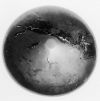|

Click to enlarge |
A thin highly symmetrical full-grooved axe head found in the 1970s in Cocke County, Tennessee along the French Broad River. It is 7 1/2 inches long by 3 3/4 inches wide. It is an excellent example of a well-made Archaic period axe that dates to 2,500 to 1,000 BC. It is from the collection of Ron Harris. |

Click to enlarge |
Bannerstone found in the fall of 2001, in a plowed field south
of Raleigh, in Wake County, North
Carolina by Michael Holder. From the
collection of C. J. O'Neill. Photo
by Art Gerber. |

Click to enlarge |
a hematite cone found in the spring of 1992 in Hickman County, Tennessee. It was made of highly polished brown and black mottled hematite. It is 2 3/4 inches in diameter and 5/8 inches high. From the collection of Donna M. Baker. |

Click to enlarge |
Wingnut-type bannerstone found in Stark
County, Ohio. It was made from serpentine
a green sometimes spotted mineral. It was
featured in Knoblock's publication, plate
221. It is shown actual size. From the collection
of C. J. O'Neill. |

Click to enlarge |
An hourglass-style bannerstone made from
orange and black quartz. This artifact was
found in Louisiana, the Parish and finder, is not
known. It was featured in Knoblockís book on
plate number 133. It is shown actual size. C. J.
O'Neill collection. |

Click to enlarge |
Solid red bottle on a stand found in Crittenden County, Arkansas. It is 8 inches high and 6 inches wide. From the collection
of R.W. Lyerly. |

Click to enlarge |
The largest completed Clovis in the Mullins Cach, it is 6 3/4 inches long and is the longest Clovis found to date in Texas. From the 13 piece Mullins Cache of Clovis artifacts
found in the late Spring of 2004, in Bastrop County, Texas. The
cache consisted of completed Clovis points as well a preforms and
knives. From the collection of Mark Mullins. |

Click to enlarge |
Hardaway Tradition points. Note the serrations on the blade and the lack of beveling. David O. Rich collection. |
|
Copyright © C.S.A.S.I.
|




